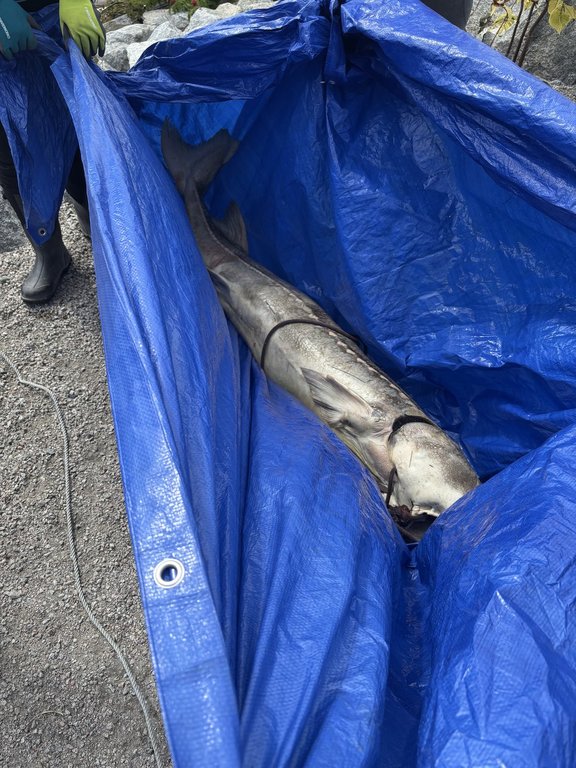Science
B.C. First Nation Launches Investigation into Sturgeon Deaths

The Tsawwassen First Nation is investigating a worrying trend of sturgeon deaths along the Fraser River in British Columbia. Earlier this month, a team of four removed the carcass of a sturgeon, measuring approximately 1.6 metres, from the riverbanks in Richmond. This was one of many such discoveries in recent weeks, prompting the First Nation to initiate a research project aimed at understanding the causes behind these mortality events.
The sturgeon carcass will be preserved for further study and eventually fitted with an electronic tracker to monitor its movements. According to Kelly Scott, a biologist with the Tsawwassen First Nation, sturgeon are often referred to as “living fossils,” having existed for around 200 million years. The recent surge in mortality is alarming, raising questions about environmental changes impacting their survival.
Scott noted, “We have received multiple reports this year from residents in New Westminster, indicating they have seen several sturgeon floating in the river simultaneously. This is very concerning.”
The British Columbia Ministry of Land, Water and Resource Stewardship has confirmed an uptick in sturgeon mortality this year. Since July 2025, there have been reports of 71 sturgeon found dead across the province, with 65 of those in the lower Fraser River. Alarmingly, 49 of these fatalities occurred in just the last four weeks. In comparison, the ministry recorded 42 deaths in the lower Fraser for all of 2024 and 14 in 2023.
White sturgeon are among the largest and longest-living fish species in the world, growing up to six metres and living for over 100 years. They hold cultural and dietary significance for the Tsawwassen First Nation, which historically harvested them for food. However, a ban on sturgeon harvesting was enacted in 1994, and First Nations across the province voluntarily ceased harvesting practices around the same time.
Despite the ban, catch-and-release fishing continues in the lower Fraser River, coinciding with recent recreational openings for sockeye salmon. Scott emphasized that numerous factors could contribute to the mortality of sturgeon, including climate change. Rising river temperatures may stress the fish, as there are fewer shaded areas to provide thermal refuge.
“There’s not a lot of areas with large, shady trees that can provide thermal refuge for the fish,” said Scott. She added that if a sturgeon is already stressed when caught in a gill net aimed at another species, it increases the risk of death.
The Tsawwassen research team is responding to reports of dead sturgeon and documenting any injuries. They aim to collect 20 carcasses for study, although many have been too decomposed to preserve. The plan involves drifting carcasses with telemetry trackers downstream to observe their movements under various conditions, including different seasons and weather patterns.
“We want to understand where and why sturgeon are dying and evaluate whether the reported deaths accurately reflect the mortality rate,” Scott explained. The team is collaborating with researchers from the University of B.C. to explore environmental genomics, a field that studies DNA and RNA from aquatic samples to learn about sturgeon habitats and stressors.
The provincial statement regarding the matter suggests that a variety of factors, including disease and elevated summer temperatures, may be causing the increase in mortality. It also noted that there is no direct evidence linking the recent salmon fishery to sturgeon deaths.
Fisheries and Oceans Canada reported that water temperatures in the Fraser River surpassed 20°C during late summer, raising the risk of stress and mortality for sturgeon at temperatures above 18°C. While the heightened fishing activity may correlate with increased reports of dead sturgeon, it also potentially contributes to more sightings.
Sturgeon are protected under federal species-at-risk legislation, with populations in the upper Fraser River, upper Columbia River, upper Kootenay River, and Nechako River classified as endangered since 2006. The lower Fraser population is considered threatened but has not been formally listed for protection.
To fish for sturgeon in the lower Fraser, a specific conservation license is required for catch-and-release angling. Provincial guidelines recommend minimizing impacts on sturgeon, advising anglers not to lift them out of the water to avoid potential internal injuries.
In 2021, British Columbia began developing a management plan for white sturgeon in the Fraser River basin, involving a steering committee co-led by provincial officials and First Nations representatives, with input from the Fisheries Department.
The investigation into sturgeon deaths continues, with the Tsawwassen First Nation working diligently to gather data and insights that could help inform conservation strategies and protect these ancient fish for future generations.
-

 Lifestyle3 weeks ago
Lifestyle3 weeks agoWinnipeg Celebrates Culinary Creativity During Le Burger Week 2025
-

 Health1 month ago
Health1 month agoMontreal’s Groupe Marcelle Leads Canadian Cosmetic Industry Growth
-

 Science1 month ago
Science1 month agoMicrosoft Confirms U.S. Law Overrules Canadian Data Sovereignty
-

 Education1 month ago
Education1 month agoRed River College Launches New Programs to Address Industry Needs
-

 Technology1 month ago
Technology1 month agoDragon Ball: Sparking! Zero Launching on Switch and Switch 2 This November
-

 Science1 month ago
Science1 month agoTech Innovator Amandipp Singh Transforms Hiring for Disabled
-

 Technology1 month ago
Technology1 month agoGoogle Pixel 10 Pro Fold Specs Unveiled Ahead of Launch
-

 Science1 month ago
Science1 month agoChina’s Wukong Spacesuit Sets New Standard for AI in Space
-

 Technology1 month ago
Technology1 month agoWorld of Warcraft Players Buzz Over 19-Quest Bee Challenge
-

 Science1 month ago
Science1 month agoXi Labs Innovates with New AI Operating System Set for 2025 Launch
-

 Business4 weeks ago
Business4 weeks agoDawson City Residents Rally Around Buy Canadian Movement
-

 Business1 month ago
Business1 month agoNew Estimates Reveal ChatGPT-5 Energy Use Could Soar
-

 Technology1 month ago
Technology1 month agoFuture Entertainment Launches DDoD with Gameplay Trailer Showcase
-

 Technology1 month ago
Technology1 month agoGlobal Launch of Ragnarok M: Classic Set for September 3, 2025
-

 Technology1 month ago
Technology1 month agoInnovative 140W GaN Travel Adapter Combines Power and Convenience
-

 Technology1 month ago
Technology1 month agoNew IDR01 Smart Ring Offers Advanced Sports Tracking for $169
-

 Technology1 month ago
Technology1 month agoHumanoid Robots Compete in Hilarious Debut Games in Beijing
-

 Science1 month ago
Science1 month agoNew Precision Approach to Treating Depression Tailors Care to Patients
-

 Health1 month ago
Health1 month agoGiant Boba and Unique Treats Take Center Stage at Ottawa’s Newest Bubble Tea Shop
-

 Technology1 month ago
Technology1 month agoQuoted Tech Launches Back-to-School Discounts on PCs
-

 Technology1 month ago
Technology1 month agoArsanesia Unveils Smith’s Chronicles with Steam Page and Trailer
-

 Education1 month ago
Education1 month agoAlberta Teachers’ Strike: Potential Impacts on Students and Families
-

 Technology1 month ago
Technology1 month agoDiscover the Relaxing Charm of Tiny Bookshop: A Cozy Gaming Escape
-

 Technology1 month ago
Technology1 month agoRaspberry Pi Unveils $40 Touchscreen for Innovative Projects










